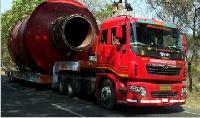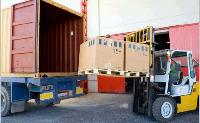
Warehouse Services
A warehouse is a commercial building for storage of goods. Warehouses are used by manufacturers, importers, exporters,wholesalers, transport businesses, customs, etc. They are usually large plain buildings in industrial areas of cities, towns and villages.They usually have loading docks to load and unload goods from trucks. Sometimes warehouses are designed for the loading and unloading of goods directly from railways, airports, or seaports. They often have cranes and forklifts for moving goods, which are usually placed on ISO standard pallets loaded into pallet racks. Stored goods can include any raw materials, packing materials, spare parts, components, or finished goods associated with agriculture, manufacturing and production. In Indian English a warehouse may be referred to as a godown.
...more
Transportation Services
Freight transport is the physical process of transporting commodities and merchandise goods and cargo. The term shipping originally referred to transport by sea, but is extended in American English to refer to transport by land or air (International English: "carriage") as well. "Logistics", a term borrowed from the military environment, is also fashionably used in the same sense.Before containerization ,goods were usually handled manually as break bulk cargo. Typically, goods would be loaded onto a vehicle from the factory and taken to a port warehouse where they would be offloaded and stored awaiting the next vessel. When the vessel arrived, they would be moved to the side of the ship along with other cargo to be lowered or carried into the hold and packed by dock workers. The ship might call at several other ports before off-loading a given consignment of cargo. Each port visit would delay the delivery of other cargo. Delivered cargo might then have been offloaded into another warehouse before being picked up and delivered to its destination. Multiple handling and delays made transport costly, time consuming and unreliable.
...more
Over Dimensional Cargo (ODC)
Transportation, cargo or freight are goods or produce being conveyed – generally for commercial gain by ship, boat, or aircraft, although the term is now often extended to cover all types of freight including that carried by train, van, truck, oriented. The term cargo is also used in case of goods in the cold-chain, because the perishable inventory is always in transit towards a final end-use, even when it is held in cold storage or other similar climate-controlled facility.Multi-modal container units, designed as reusable carriers to facilitate unit load handling of the goods contained, are also referred to as cargo, specially by shipping lines and logistics operators. Similarly, aircraft ULD boxes are also documented as cargo, with associated packing list of the items contained within. When empty containers are shipped each unit is documented as a cargo and when goods are stored within, the contents are termed as containerised cargo.
...more
Logistics Services
We are trustworthy name providing complete solutions related to packaging, warehousing, distribution and inventory management. A group of qualified professionals is entrusted to work in coordination with clients, understand their requirements and execute the task accordingly. With our Logistic Services, we provide round the clock services to our clients. Also, we make use of quality material for packaging and ensure that the consignment reaches its destination within the said timeframe. To more about our services, one can approach us through our website.
...more
LCL Cargo
Containerization is a system of intermodal freight transport using intermodal containers (also called shipping containers and ISO containers) made of weathering steel. The containers have standardized dimensions. They can be loaded and unloaded, stacked, transported efficiently over long distances, and transferred from one mode of transport to another-container ships, rail transport flatcars, and semi-trailer trucks-without being opened. The handling system is completely mechanized so that all handling is done with cranes and special forklift trucks. All containers are numbered and tracked using computerized systems.The system, developed after World War II, dramatically reduced transport of its costs, supported the post-war boom in international, and was a major element in globalization. Containerization did away with the manual sorting of most shipments and the need for warehousing. It displaced many thousands of dock workers who formerly handled break bulk cargo. Containerization also reduced congestion in ports, significantly shortened shipping time and reduced losses from damage and theft.
...more
Computer Networking
Be first to Rate
Rate This